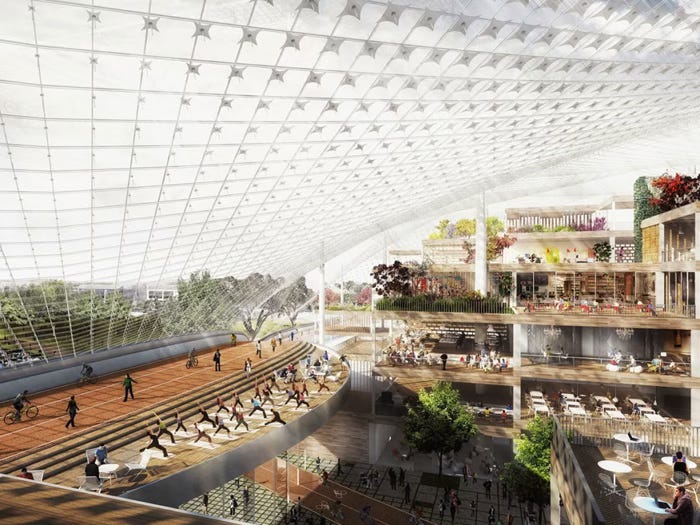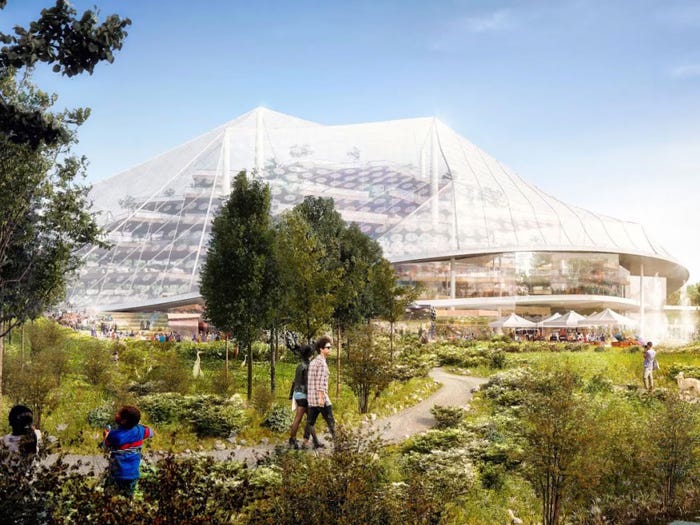March 2015 | Eyesore
Commentary on architectural blunders in monthly serial.
Behold the proposed new Google headquarters, Mountain View (Silicon Valley), CA. Google, of course, has enough walking around money in its deep pockets to indulge in the most fantastic architectural status stunt — meaning that the diminishing returns of great wealth and cleverness will bite extra hard. This, uh, structure, by Bjark Ingles and Thomas Heatherstone employs all the dishonest tropes of our time in order to achieve techno-narcissist lift-off: 1.) the idea that buildings should erase the boundary between being inside and outside; 2) that “nature” is the sovereign remedy for the failure to provide real urbanism; that space functions best when it lacks definition; that work is really just play; and perhaps most insidious, that the modular fabricated materials of today will age gracefully and be repairable. I would not bet on that outcome at all. They say that empires build their most grandiose and grotesque monuments just before they collapse, and Google is kind of a sub-empire of the greater USA techno-clown empire. As the late Rod Serling might say: “…submitted for your approval, a mausoleum for the Information Age….”
Below, check out the childishly-conceived nature installation in all its greenwashed ambiguity. This is the kind of trendoid “landscape urbanism” crap promoted by the Harvard Graduate School of Design. Basically, a park minus artistry. Looks like it was designed by the late Thomas Kinkaid for a creation museum diorama.
Below illustration, find additional comments by Catherine Johnson
Additional Informed Comments
By Catherine Johnson
Middletown, Connecticut
Licensed Architect, Charter Member Congress for the New Urbanism.
(cjdraws@gmail.com)
Google wants a flexible building. “It is our responsibility to build something that reflects Our Age – technology.” Thus the proposed Erector Set with Stretchy Glass Stocking on top where you can have “a car factory or, after 5 years, something else!” But, poor Googlers, you’ve missed the mark. You’re trying too hard to be groovy. Your goal shouldn’t be on making a literal manifestation of “technology” on the building skin, but rather creating spaces that work best for human beings, and creating the habitat to support their psychological and physical well-being.The focus should not be on inventing new materials to build with, but on creating the kinds of spaces that humans seek and feel good in: intimate spaces, both inside and outside buildings, places with variety of activities, places where one can find stimulation and other places for self-refection.
The space for supporting human activity has changed very little over the past 8,000 years. We still use incredible stone factory buildings from two hundred years ago. Why? Their flexibility comes from of a size and design that reinforce a wide spectrum of human activity (dimension, height, permit natural light and air). Second, they were put IN THE RIGHT PLACE to begin with. They work because they are invariably located in a downtown where there are other things to do, both useful and for pleasure, day and night, accessible by foot rather than only a private vehicle sent specifically for that purpose.
Build something that can be reused not only after 5-15 years, but after Google is gone. If you choose right, you can have a building that will support creative human endeavor for hundreds of years, making hundreds of different types of products, and you won’t have to “rip it down after 5 years.” You plan to build Rouge River when you should really be building Highland Park.
Maybe you are looking to other tech companies for ideas about how to approach creating modern office workspace, but you’re looking at the wrong models. The “office park in the prairie” complexes are of a 1970’s mindset. Places of business cannot be isolated, no matter how large, in a world of its own creating and last over the long haul. Your Erector Set building will never be recycled, renovated, or worse, able to be sold. Its odd novelty will make it the least flexible building ever conceived. The flashy photo of today will become the icon of a mistake, showing a company who didn’t understand true green buildings rely on the technology formed over millennia instead of the last 15 minutes.
If Stretchy Glass was such a good idea, Buckminster Fuller have already done it 60 years ago. This building is obsolete and nary a sky-brella has even opened. Make you mark by doing something completely radical: look at traditional buildings that stood the test of time, buildings that are beloved for their design, buildings that support humanity not the technology that may operate within them.






